cross breeding chickens chart pdf
Cross breeding chickens combines different breeds to enhance traits like egg production, meat quality, and disease resistance. This method leverages genetic diversity for improved outcomes, guided by detailed charts.
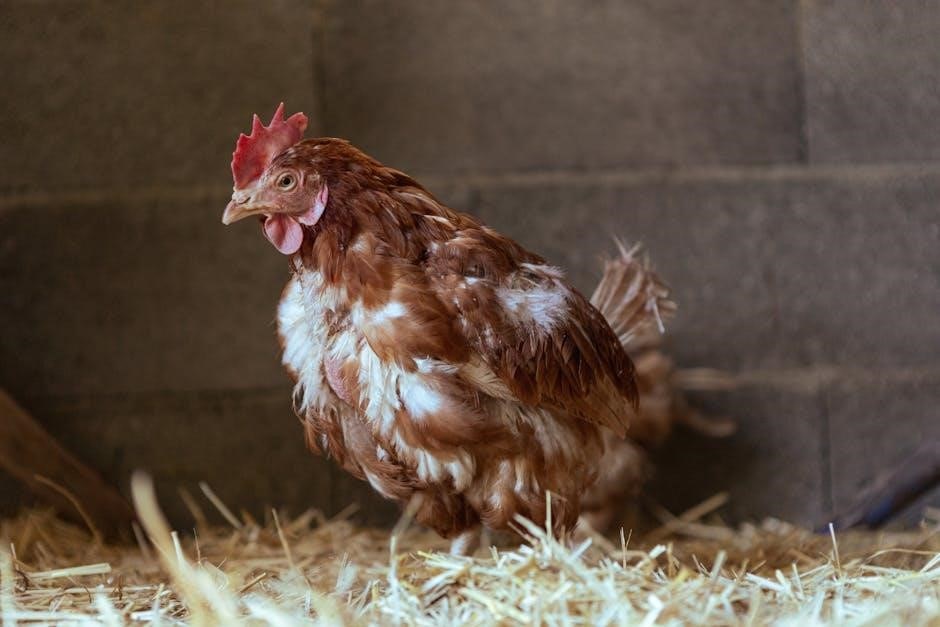
What is Cross Breeding in Chickens?
Cross breeding in chickens involves mating birds of different breeds or genetic lines to produce offspring with desirable traits. This technique leverages genetic diversity to enhance characteristics like egg production, meat quality, or disease resistance. By understanding inheritance patterns and using cross breeding charts, breeders can predict offspring traits, such as egg color, size, or feather patterns. These charts simplify complex genetic interactions, making it easier to achieve specific breeding goals effectively.
Why Cross Breed Chickens?
Cross breeding chickens is a strategic approach to combine desirable traits from different breeds, such as egg production, meat quality, or disease resistance. It enhances genetic diversity, improving overall flock performance and adaptability. By leveraging a cross breeding chart, breeders can predict offspring characteristics, ensuring traits like higher egg yield or faster growth rates. This method also promotes sustainability and profitability, making it a key tool for meeting diverse production needs in various climates and management systems.
Understanding the Cross Breeding Chart
A cross breeding chart is a vital tool for predicting genetic outcomes in chicken breeding. It maps parent breed combinations to forecast traits in offspring, such as egg color, feather type, or growth rate. By analyzing genotype pairings, breeders can anticipate phenotypic results, ensuring desired characteristics. This chart simplifies complex genetics, making it easier to plan breeding programs effectively. It also helps in identifying compatible breeds for specific production goals, such as egg production or meat quality, enhancing overall efficiency and success in cross breeding efforts.
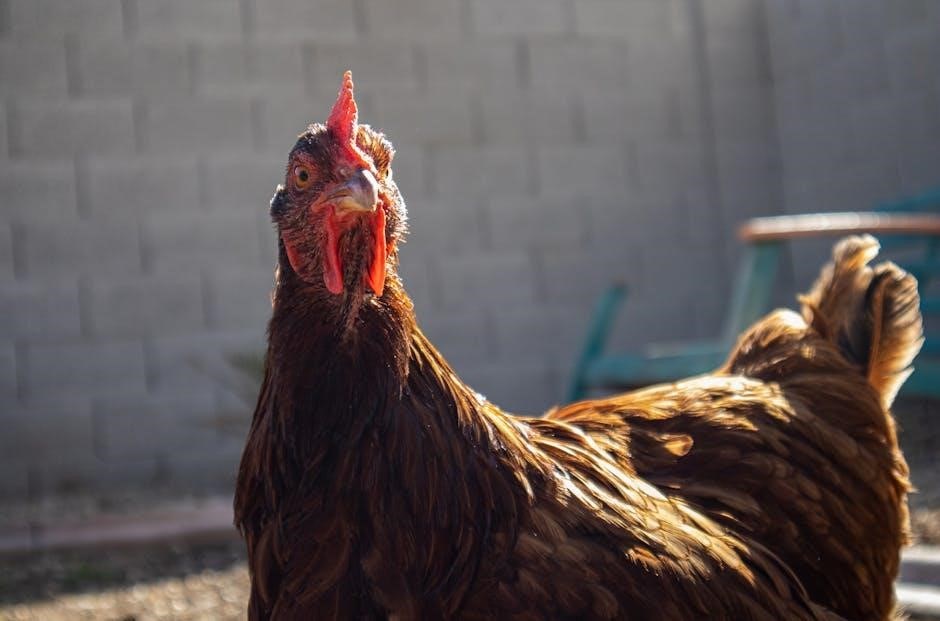
Genetic Basics of Chicken Cross Breeding
Genetics play a crucial role in cross breeding, guiding breed selection to produce desired traits. Principles like dominance, recessiveness, and sex-linkage determine offspring characteristics, ensuring predictable outcomes and improving productivity and sustainability in chicken breeding programs.
Genetics and Trait Inheritance
Genetics and trait inheritance are fundamental to cross breeding chickens. Mendelian principles govern how traits like egg color, feathering, and comb type are passed to offspring. DNA carries genetic information, with specific genes determining traits. Alleles, variants of genes, dictate whether traits are dominant or recessive. Understanding inheritance patterns is crucial for predicting offspring characteristics, enabling breeders to use cross breeding charts effectively to achieve desired outcomes, such as improved egg production or disease resistance, aligning with breeding goals and genetic diversity.
Dominant and Recessive Traits
Dominant and recessive traits play a key role in cross breeding chickens. Dominant traits, like black feathering, will always express if the gene is present, while recessive traits, such as blue or splash feathers, only appear when two recessive alleles are inherited. Understanding these genetic interactions is vital for predicting offspring characteristics. Cross breeding charts help visualize how dominant and recessive traits combine, enabling breeders to plan matings that produce desired features, such as egg color or feather patterns, with greater accuracy and consistency in their flocks.
Sex-Linked Traits in Chickens
Sex-linked traits in chickens are influenced by genes located on the Z and W chromosomes. Males (ZZ) and females (ZW) inherit these traits differently. For example, traits like barred feathering or certain plumage colors are linked to the Z chromosome. Cross breeding charts help predict how these traits will pass to offspring. Females often require two copies of a recessive allele to express a trait, while males only need one. Understanding sex-linked traits is crucial for achieving desired characteristics in cross breeding programs, ensuring predictable and successful outcomes in chicken breeding projects.
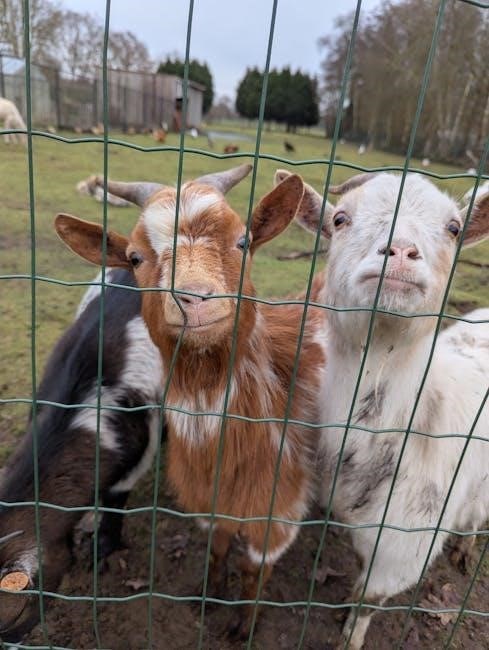
Popular Chicken Breeds for Cross Breeding
Popular breeds include Ameraucana, Orpington, Rhode Island Red, and Brahma. These breeds offer unique traits like egg production, size, and temperament, making them ideal for cross breeding programs.
Ameraucana: The Blue Egg Layer
The Ameraucana is a unique breed known for laying blue eggs, a result of a genetic trait. Originating in South America, it’s prized for its hardiness and friendly nature. In cross breeding, the Ameraucana’s genes are often sought for their ability to produce offspring with diverse egg colors. When crossed with other breeds like Leghorns, they can create hybrids with improved egg production and unique shell hues. Their calm temperament also makes them a great choice for backyard flocks. This breed is a valuable asset in cross breeding programs aiming for genetic diversity and specific traits.
Orpington: The Friendly Giant
The Orpington is a large, friendly breed renowned for its gentle nature and impressive size. Originating in England, it’s widely used in cross breeding to enhance egg production and meat traits. Known for its soft, fluffy feathers, the Orpington adds desirable characteristics to offspring, such as docility and hardiness. When crossed with breeds like Leghorns or Brahmas, it creates hybrids that balance productivity and temperament. Their adaptability makes them a popular choice for both backyard and commercial cross breeding programs, ensuring robust and versatile offspring.
Rhode Island Red: The Productive Layer
Rhode Island Reds are a cornerstone of cross breeding programs due to their exceptional egg-laying ability and adaptability. Known for producing over 200 brown eggs annually, they are highly sought after for improving productivity in offspring. Their friendly, hardy nature makes them ideal for cross breeding, ensuring robust hybrids. When crossed with breeds like Leghorns or Barred Rocks, they yield offspring with enhanced egg production and temperament. Their versatility in both backyard and commercial settings makes them a key choice for achieving balanced, productive results in cross breeding efforts.
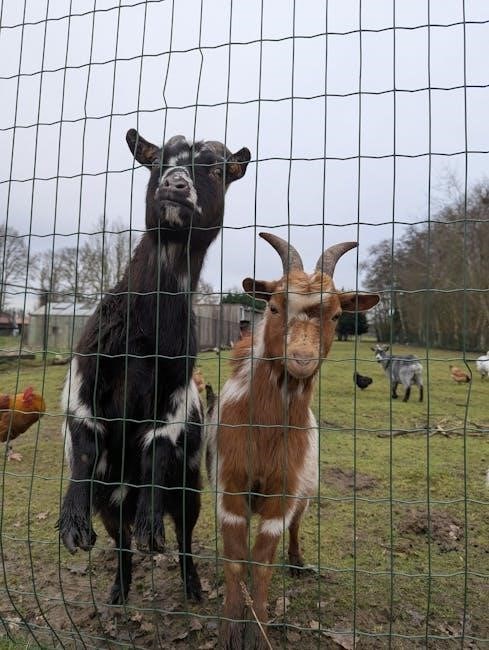
Brahma: The Cold-Hardy Giant
Brahmas are renowned for their exceptional size, cold hardiness, and gentle disposition, making them a valuable choice for cross breeding. Originating from India, they are large birds with feathered legs and a broad frame. Brahmas lay moderate-sized eggs and are excellent for meat production. Their ability to thrive in cooler climates and robust health makes them ideal for cross breeding to enhance size and hardiness in offspring. Their calm temperament also contributes to easier management in breeding programs, ensuring desirable traits in hybrid chickens.
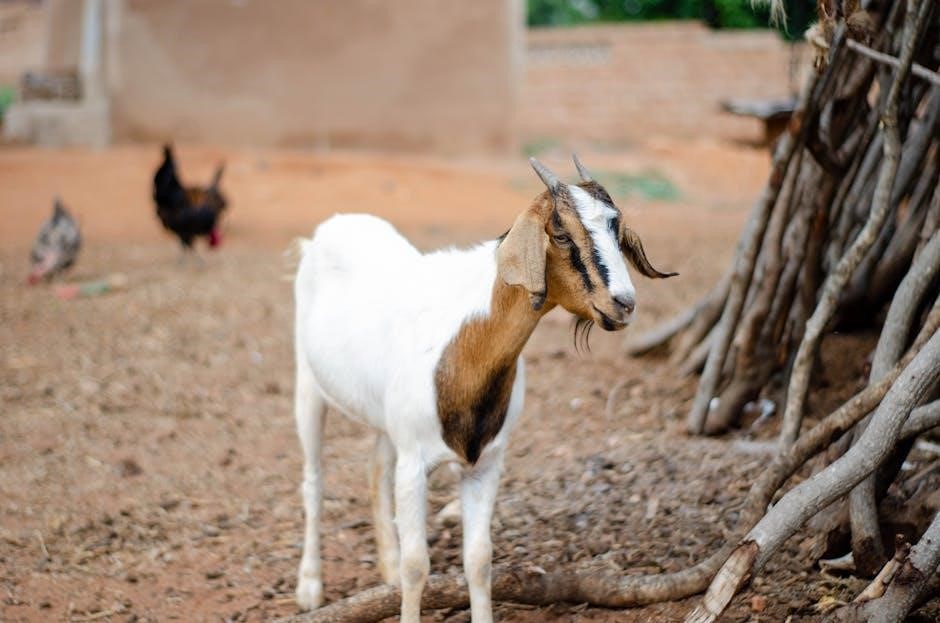
Understanding the Cross Breeding Chart
A cross breeding chart is a vital tool for predicting offspring traits by mapping genetic combinations, ensuring desired characteristics in hybrid chickens. It aids breeders in planning crosses effectively.
How to Read a Cross Breeding Chart
Reading a cross breeding chart involves understanding its structure and symbols. Typically, charts display parent breeds on the x and y axes, with offspring traits in the grid. Colors or codes represent specific traits like feather color or egg type. Start by identifying the breeds involved, then locate their intersection to predict offspring characteristics. Pay attention to abbreviations and legends provided. This tool helps breeders anticipate genetic outcomes, ensuring desired traits in hybrid chickens. Accurate interpretation requires basic genetic knowledge.
Key Characteristics to Look For
When analyzing a cross breeding chart, focus on traits like egg color, size, and production rate, as well as feather type, comb style, and growth rate. These characteristics help predict offspring quality. Look for disease resistance, temperament, and climate adaptability, which are critical for productivity. Ensure the chart highlights both dominant and recessive traits, as this influences outcomes. Prioritize traits based on your breeding goals, whether for eggs, meat, or unique features. This ensures your program meets specific needs and expectations.
Using the Chart for Predictable Results
A well-designed cross breeding chart allows breeders to predict offspring traits with accuracy. By aligning parent breeds with desired outcomes, you can anticipate egg production, feather patterns, and growth rates. Consistent use of the chart ensures genetic diversity and reduces unforeseen traits. Regularly updating the chart with new data enhances its reliability. This tool is essential for achieving specific breeding goals and maintaining consistent flock performance over generations.
Growth and Performance in Cross Breeding
Cross breeding optimizes growth rates and performance in chickens, enhancing egg production, meat yield, and overall flock efficiency through strategic genetic combinations.
Growth Curves in Cross Bred Chickens
Growth curves in cross-bred chickens illustrate the rate of development from hatch to maturity, influenced by genetics, nutrition, and breed combinations; These curves help predict feed efficiency, weight gain, and egg production. Cross-breeding charts reveal optimal hybrid vigor, ensuring faster growth and higher productivity. By analyzing these curves, breeders can identify superior genetic lines, enhancing overall flock performance and profitability. Properly designed charts ensure predictable outcomes, making them essential tools for modern poultry production systems focused on sustainability and efficiency.
Body Weight and Meat Production
Body weight and meat production in cross-bred chickens are significantly influenced by genetic diversity and selective breeding. Cross-breeding charts highlight optimal combinations for maximizing muscle growth and feed efficiency. Breeds like Cornish Cross, known for rapid weight gain, are often crossed with Plymouth Rock or Rhode Island Red for improved meat quality. This results in birds with higher body mass and better carcass traits, making them ideal for commercial poultry production. Proper genetic selection ensures consistent meat yield and profitability for farmers.
Egg Production and Egg Quality
Cross-breeding chickens can significantly enhance egg production and quality. Breeds like Leghorns, known for high egg yield, are often crossed with Orpingtons or Ameraucanas to improve shell strength and yolk color. The cross-breeding chart helps predict egg-laying traits, ensuring optimal combinations for desired outcomes. Farmers can achieve higher egg production rates while maintaining quality by selecting breeds with complementary genetic traits. This approach ensures consistent and profitable egg production for both backyard and commercial farming setups.
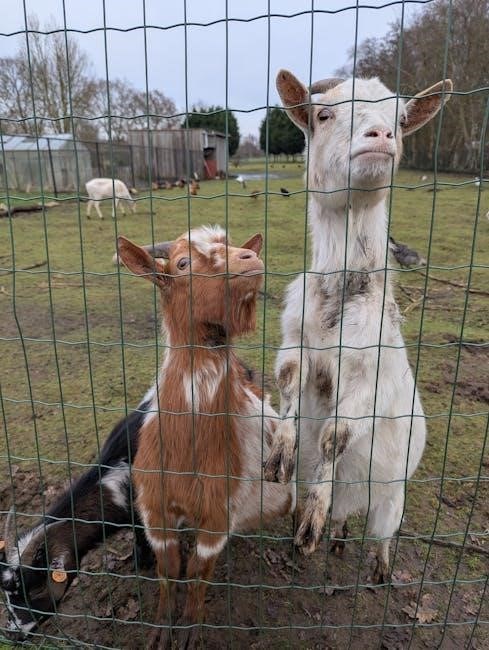
Local Breeds and Their Crosses
Local chicken breeds offer unique genetic diversity, making them ideal for cross-breeding to enhance adaptability, resilience, and productivity in various farming environments and conditions.
Local Breeds for Cross Breeding
Local chicken breeds, such as the Asil or Shamo, are often used in cross-breeding programs due to their adaptability, hardiness, and unique genetic traits. These breeds thrive in diverse environments, making them ideal for improving the resilience of commercial or backyard flocks. Cross-breeding local breeds with more specialized varieties can enhance traits like egg production, meat quality, or disease resistance. A cross-breeding chart helps breeders predict offspring characteristics, ensuring desired outcomes. Local breeds are a valuable resource for sustainable poultry production, offering genetic diversity and practical advantages for farmers.
Advantages of Cross Breeding Local Breeds
Cross-breeding local chicken breeds offers several advantages, including improved adaptability, resilience, and heterosis. Hybrid offspring often exhibit better growth rates, fertility, and disease resistance compared to purebred parent lines. This approach enhances economic benefits by increasing egg production, meat yield, and overall flock productivity. Additionally, cross-breeding local breeds helps preserve genetic diversity while addressing specific climatic or market demands. Farmers can achieve lower mortality rates and better feed efficiency, making cross-breeding a sustainable and profitable strategy for modern poultry production.
Examples of Successful Local Crosses
Successful local chicken crosses include Rhode Island Red x Leghorn, known for high egg production, and Plymouth Rock x Orpington, combining cold hardiness with friendly temperament. The Golden Comet, a cross between Rhode Island Red and Leghorn, is renowned for its prolific egg-laying. Another example is the Isa Brown, a cross of Rhode Island Reds and Whites, offering excellent adaptability. These crosses demonstrate improved productivity, disease resistance, and adaptability, benefiting both backyard farmers and commercial operations while promoting genetic diversity and sustainable poultry practices.
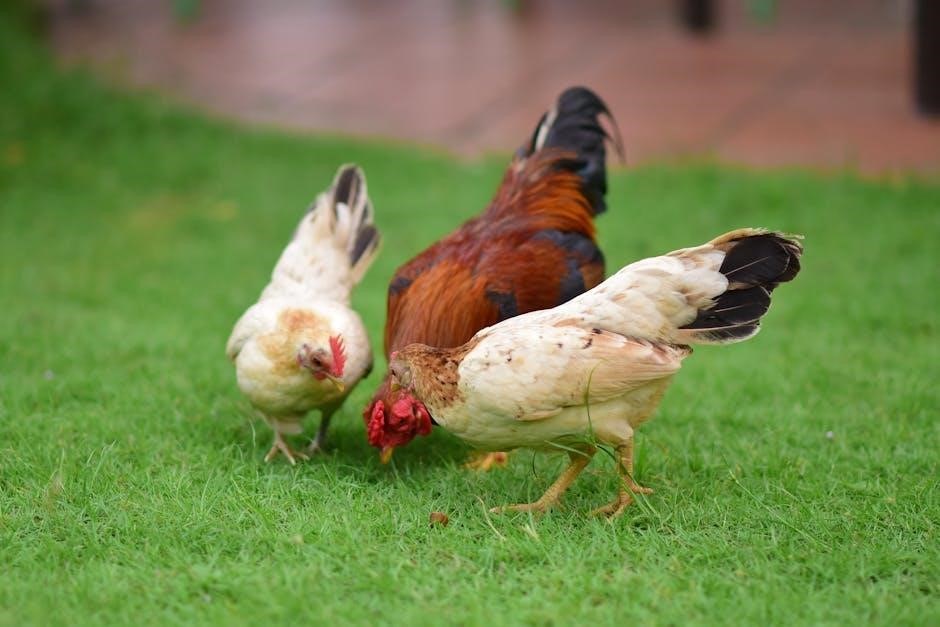
Commercial Genotypes in Cross Breeding
Commercial genotypes like Ross 308 are bred for high productivity, fast growth, and disease resistance, making them ideal for large-scale poultry production and profitable crossbreeding programs, ensuring consistent egg and meat yields.
Commercial Breeds for Cross Breeding
Commercial chicken breeds like Ross 308, Cobb 500, and Hubbard are widely used in crossbreeding due to their exceptional growth rates, high egg production, and adaptability. These breeds are selected for their ability to thrive in various environments while maintaining productivity. Their genetic makeup ensures robust hybrids, making them ideal for both egg and meat production systems. Crossbreeding with commercial strains often results in offspring with improved feed efficiency, disease resistance, and faster maturation, enhancing overall profitability for poultry farmers and backyard breeders alike.
Ross 308 and Other Commercial Genotypes
The Ross 308 is a leading commercial broiler genotype known for its rapid growth rate, high feed efficiency, and robust health. Other commercial genotypes like Cobb 500 and Hubbard are equally popular for their adaptability and productivity. These breeds are often crossed with local or heritage breeds to enhance meat yield and disease resistance. Their genetic diversity ensures hybrid vigor, making them ideal for large-scale poultry operations. Crossbreeding charts often highlight these genotypes due to their consistent performance and versatility in various production systems.
Performance of Commercial Crosses
Commercial crosses, such as Ross 308 and Cobb 500, are bred for exceptional performance, delivering high growth rates, superior feed efficiency, and robust health. These hybrids excel in meat production, reaching market weight quickly while maintaining low mortality rates. Egg-laying crosses, like Hy-Line, offer consistent egg production and durability. Performance is measured through growth curves, feed conversion ratios, and disease resistance. Crossbreeding charts predict these outcomes, ensuring farmers achieve optimal results. Such crosses are tailored to meet market demands, balancing productivity with adaptability and profitability in modern poultry systems.
Hatchability and Fertility in Cross Breeding
Hatchability and fertility are critical in cross breeding, influenced by factors like breed compatibility, genetic diversity, and incubation conditions. Cross breeding charts predict these outcomes, ensuring optimal results in egg production and chick viability. Proper breeding strategies enhance fertility rates and improve hatchability, leading to successful and sustainable poultry production.
Hatchability Rates in Cross Bred Chickens
Hatchability rates in cross bred chickens vary based on genetic factors, parental breed, and incubation conditions. Cross breeding charts help predict these rates, ensuring successful outcomes. Breeds like Rhode Island Reds and Leghorns often show higher hatchability due to their robust genetics. Environmental factors, such as temperature and humidity, also play a role. By using a cross breeding chart, breeders can select pairs likely to produce viable eggs, maximizing fertility and hatch success. This data is essential for optimizing poultry production.
Fertility and Breeding Success
Fertility and breeding success in cross bred chickens depend on genetic compatibility, health, and environmental conditions. Cross breeding charts guide breeders in selecting compatible breeds to maximize fertility. Factors like nutrition, age, and stress levels also influence breeding outcomes. Healthy, disease-free parents are crucial for successful fertilization. Using a cross breeding chart ensures breeders choose pairs with high fertility potential, leading to better hatching rates and robust offspring. Proper management practices further enhance breeding efficiency, ensuring sustainable poultry production.
Factors Affecting Hatchability
Hatchability in cross bred chickens is influenced by incubation conditions, genetics, and egg quality. Temperature, humidity, and egg turning during incubation are critical for successful hatching. Poor incubation practices can significantly reduce hatch rates. Additionally, the health and genetic makeup of the parent stock play a role in embryo viability. Age of the egg before incubation and infections during incubation also impact hatchability. Cross breeding charts help identify compatible breeds and optimal conditions, ensuring higher hatch success for cross bred chickens.
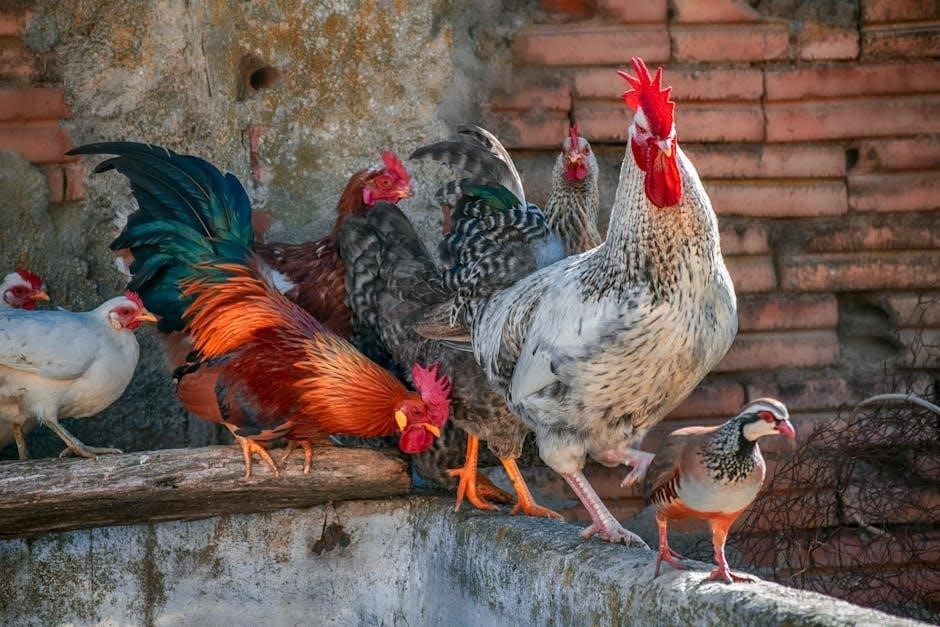
Health Implications of Cross Breeding
Cross breeding chickens can improve hybrid vigor, reducing inbreeding issues. However, it may also introduce genetic disorders or disease susceptibility, requiring careful breed selection and monitoring.
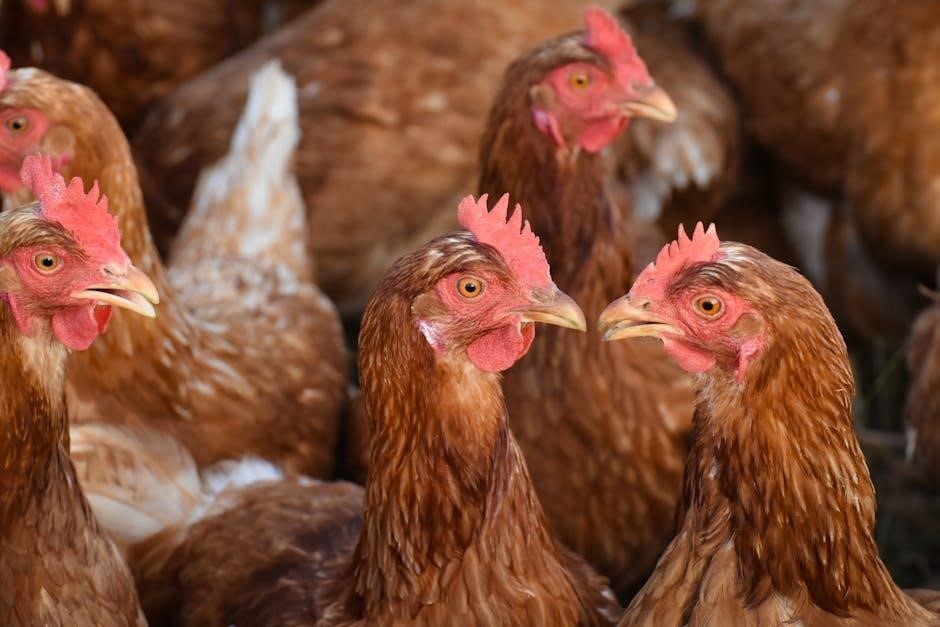
Health Benefits of Cross Breeding
Cross breeding chickens can enhance hybrid vigor, leading to stronger, more resilient birds. This reduces the risk of inherited health issues and improves disease resistance. Mixed-breed chickens often exhibit better immune systems and lower mortality rates compared to purebred counterparts. Additionally, genetic diversity introduced through cross breeding can reduce the likelihood of breed-specific health disorders. Proper selection of parent breeds ensures robust offspring, making cross breeding a valuable strategy for promoting overall flock health and sustainability in both backyard and commercial settings.
Health Challenges in Cross Bred Chickens
Cross bred chickens may face health challenges due to genetic unpredictability. Some crosses can result in weaker immune systems or increased susceptibility to diseases. Skeletal issues may arise in fast-growing breeds, while others might experience reproductive difficulties. Additionally, certain crosses can lead to higher mortality rates or reduced longevity. Proper selection of parent breeds and careful management are crucial to minimize these risks and ensure the health of cross bred chickens.
Disease Resistance in Cross Breeds
Cross breeding chickens can enhance disease resistance by introducing diverse genetic traits. Certain breeds carry genes that offer natural resistance to specific illnesses, which can be passed to offspring. This hybrid vigor strengthens the immune system, reducing susceptibility to common poultry diseases. Farmers often cross breed to create resilient flocks, lowering mortality rates and reducing the need for antibiotics. This approach not only promotes healthier chickens but also aligns with sustainable poultry practices, ensuring long-term productivity and flock well-being.
Creating Your Own Cross Breeding Chart
Understand genetic principles, develop a structured plan, and organize data to design an accurate cross breeding chart for predictable chicken hybrid outcomes using reliable tools.
Steps to Design a Cross Breeding Chart
To create a cross breeding chart, start by selecting parent breeds based on desired traits. Plan breeding objectives, such as egg production or meat quality. Organize genetic data, including ancestry and trait inheritance. Document expected offspring characteristics using Punnett squares. Track and record results to refine predictions. Use software or spreadsheets for accuracy. Regularly update the chart with new data and breeding outcomes to ensure reliability and improve future results.
Including Key Traits and Characteristics
When designing a cross breeding chart, prioritize traits like egg production, meat quality, feather color, and disease resistance. Categorize traits into production, physical, and genetic characteristics. Include inheritance patterns, such as dominant or recessive genes. Note sex-linked traits and their expression in offspring. Add anecdotal observations for clarity. This ensures the chart is comprehensive and useful for predicting outcomes. Properly documenting these traits helps breeders make informed decisions and achieve desired results in their breeding programs.
Using Online Resources and Tools
Utilize online resources and tools to enhance cross breeding efforts. Websites offer detailed cross breeding charts in PDF formats, providing insights into genetic traits and outcomes. Tools like Punnett square calculators and genetic trait predictors are invaluable for planning. Forums and breeding communities share experiences and strategies. Accessing these resources online allows breeders to make informed decisions efficiently. Databases and libraries also provide comprehensive guides for successful cross breeding programs, ensuring optimal results and minimizing uncertainties in the breeding process.
Best Practices for Chicken Breeders
Adhere to best practices by maintaining detailed records, selecting high-quality breeding stock, and ensuring proper pen management. Regularly consult cross breeding charts and genetic resources to optimize results and achieve desired traits efficiently.
Selecting Breeding Stock
Selecting high-quality breeding stock is crucial for successful cross breeding. Choose birds with desirable traits, such as egg production, meat quality, or feather color, aligned with your goals. Ensure genetic diversity to avoid inbreeding issues. Health status is paramount; select birds with robust immune systems and no signs of disease. Consult cross breeding charts to identify compatible breeds and predict offspring traits. Record pedigrees and performance data to make informed decisions. Proper selection ensures predictable outcomes and improves breeding efficiency.
Managing Breeding Pens
Managing breeding pens involves organizing the environment to optimize breeding success. Maintain a clean, well-ventilated space with adequate space per bird to prevent overcrowding. Provide high-quality feed to ensure health and productivity. Keep detailed records of each bird’s lineage and breeding performance. Regularly monitor health and maintain biosecurity to prevent disease spread. Separate chickens by breed or genetic line to control mating and ensure desired traits. Proper management enhances fertility, productivity, and the overall effectiveness of the cross breeding program.
Record Keeping for Successful Breeding
Accurate record keeping is essential for successful cross breeding programs. Maintain detailed records of each bird’s pedigree, breeding history, and production data. Track egg laying, fertility rates, and hatchability to identify top performers. Document genetic traits, growth rates, and health status to make informed decisions. Use charts or spreadsheets to organize data, ensuring traceability and consistency. Regular analysis of records helps refine breeding strategies, improve outcomes, and achieve long-term goals in cross breeding chickens.
Future of Cross Breeding in Chicken Production
Advancements in genetic research and technology will drive efficient cross breeding, enhancing productivity, disease resistance, and sustainability in poultry production systems globally.
Advancements in Genetic Research
Genetic research is revolutionizing cross breeding by identifying key genes influencing egg production, meat quality, and disease resistance. Tools like CRISPR enable precise trait manipulation, ensuring healthier, more productive birds. Advances in genomics help breeders predict offspring traits, optimizing cross breeding charts for desired outcomes. Big data and AI further enhance predictive breeding programs, leading to resilient, high-performing chicken strains. These innovations are paving the way for sustainable poultry production, reducing environmental impact while meeting growing global demand for protein.
Sustainable Breeding Practices
Sustainable breeding practices focus on ethical, eco-friendly methods to improve chicken productivity. By prioritizing natural mating processes and reducing reliance on chemicals, breeders can maintain healthy flocks. Selecting breeds adapted to local climates ensures resilience and reduces resource use. Cross breeding charts help plan matings that enhance desired traits while preserving genetic diversity; These practices promote long-term sustainability, supporting both environmental health and the livelihoods of poultry farmers. They also align with global efforts to reduce the environmental impact of livestock production.
The Role of Cross Breeding Charts in Future Production
Cross breeding charts are pivotal in future chicken production, enabling breeders to predict and optimize outcomes. These tools provide a roadmap for combining breeds to achieve desired traits, such as egg production or meat quality. By analyzing genetic data, charts help select optimal parent lines, ensuring efficient resource use. As technology advances, digital charts will integrate AI for precise predictions, making breeding more accurate and sustainable. This data-driven approach will be crucial for meeting global food demands while maintaining genetic diversity and resilience in flocks.
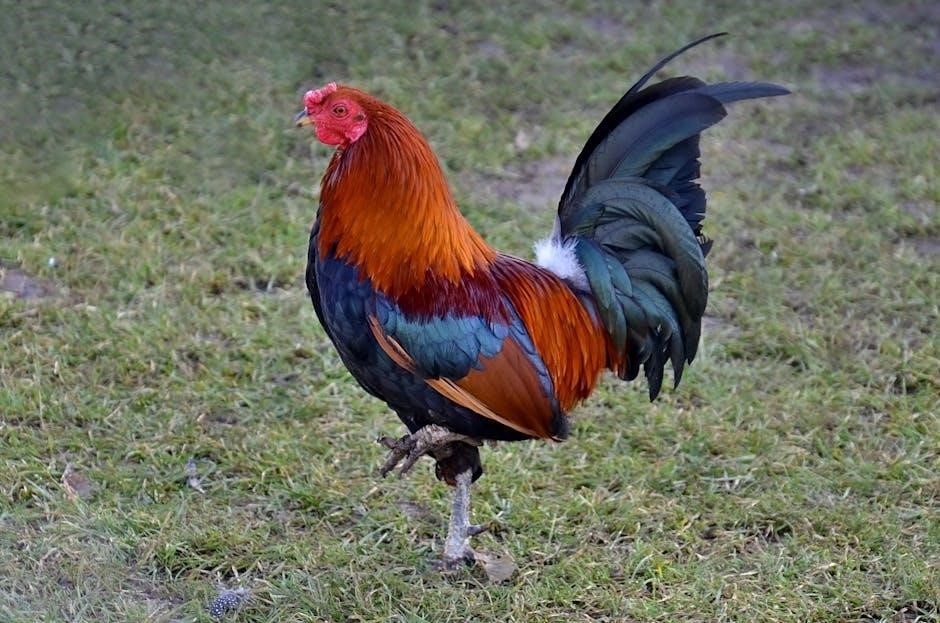










Leave a Comment